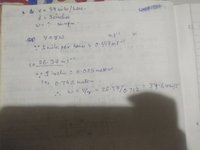rachelmaddie
Full Member
- Joined
- Aug 30, 2019
- Messages
- 851
Hi. I need my work checked please.

First, find the circumference of the wheel
C = 2πr
We know that the radius is half of the diameter.
r = 30/2 = 15 inches
Substitute this into the equation:
C = 2π(15)
C = 30π inches
Pi (π)= 3.14
C = 30(3.14) = 94.2 inches
Note that the circumference of the wheels represent one revolution.
Convert 59 miles per hour to inches per minute
59 mi/hr = 59*63, 360/60 = 62, 304 in/min
Set up a proportion to find the number of revolutions:
revolution/inches = revolution/inches
We know that 1 mile = 63, 360 inches
1/94.2 = x/62,304
x = 62,304/94.2
x = 661.4 rev
Therefore, 62,304 in/min = 661.4 in/min = 661.4 rpm
Solution: 661.4 revolutions per minute (rpm)

First, find the circumference of the wheel
C = 2πr
We know that the radius is half of the diameter.
r = 30/2 = 15 inches
Substitute this into the equation:
C = 2π(15)
C = 30π inches
Pi (π)= 3.14
C = 30(3.14) = 94.2 inches
Note that the circumference of the wheels represent one revolution.
Convert 59 miles per hour to inches per minute
59 mi/hr = 59*63, 360/60 = 62, 304 in/min
Set up a proportion to find the number of revolutions:
revolution/inches = revolution/inches
We know that 1 mile = 63, 360 inches
1/94.2 = x/62,304
x = 62,304/94.2
x = 661.4 rev
Therefore, 62,304 in/min = 661.4 in/min = 661.4 rpm
Solution: 661.4 revolutions per minute (rpm)

